Mar . 19, 2025 11:15

Volleyball balls for men and women may look similar, but they differ in subtle yet significant ways. These differences are not random. They are carefully designed to suit the needs of players and improve the game. For instance:
- The circumference of women’s volleyball balls ranges from 65 to 66.7 cm, while men’s volleyball balls measure between 65 and 67 cm.
- Both types weigh between 260 and 280 grams, ensuring consistency in handling.
- The air pressure for both remains between 0.30 and 0.325 kg/cm².
These specifications ensure that every match, whether played with men's volleyball or women's, delivers an optimal experience. If you're looking for a volleyball for sale, understanding these details can help you choose the right one.
Key Takeaways
- Men's and women's volleyballs are not the same size. Women's balls are smaller, measuring 65 to 66.7 cm. Men's balls are slightly bigger, measuring 65 to 67 cm.
- Both volleyballs weigh the same, between 260 and 280 grams. This makes it easier for players to handle them.
- Women's volleyballs are made for better control and accuracy. This helps players improve their skills during games.
- Knowing these differences helps players pick the right ball. This can make them play better and enjoy the game more.
- Volleyballs are designed to match players' physical abilities. This keeps the game fair and fun for everyone.
Official specifications for men's volleyball

Size and circumference
When selecting a volleyball for men's games, size and circumference are crucial factors. The official circumference for men's volleyball ranges between 65 and 67 centimeters (approximately 25.6 to 26.4 inches). This ensures consistency across matches and tournaments. The diameter of the ball falls between 20.7 and 21.3 centimeters (8.15 to 8.39 inches). These dimensions make the ball suitable for the power and precision required in men's volleyball.
Here’s a quick reference table for the measurements:
| Measurement | Value |
|---|---|
| Circumference | 65-67 cm (25.6”-26.4”) |
| Diameter | 20.7-21.3 cm (8.15”-8.39”) |
Weight and air pressure
The weight and air pressure of the ball plays a significant role in gameplay. A men's volleyball weighs between 260 and 280 grams (9 to 10 ounces). This weight strikes a balance between ease of handling and durability during intense matches. The air pressure inside the ball must remain within 0.30 to 0.325 kg/cm² (4.26 to 4.61 psi). Proper air pressure ensures the ball maintains its shape and provides a consistent bounce during play.
For clarity, here’s a breakdown of the specifications:
| Specification | Weight (grams) | Air Pressure (atm) |
|---|---|---|
| Standard indoor | 260-280 | 0.30-0.325 |
Material and design
The material and design of a men's volleyball are tailored for high-performance gameplay. Most balls are made from synthetic leather or genuine leather, offering durability and a smooth surface for better control. The panels are stitched or glued together, creating a spherical shape that enhances aerodynamics. This design allows players to execute powerful spikes and precise serves with ease.
The outer layer of the ball is slightly textured, which improves grip and handling. This feature is especially important for players who rely on quick reflexes and accurate ball placement during matches.
Official specifications for women's volleyball

Size and circumference
When choosing a volleyball for women's games, size and circumference are key factors. The official circumference for women's volleyball ranges from 65 to 66.7 centimeters (approximately 25.6 to 26.3 inches). This slightly smaller size compared to men's volleyball ensures better control and handling during play. The diameter of the ball falls between 20.7 and 21.2 centimeters (8.15 to 8.35 inches).
Here’s a quick reference table for the measurements:
| Measurement | Value |
|---|---|
| Circumference | 65-66.7 cm (25.6”-26.3”) |
| Diameter | 20.7-21.2 cm (8.15”-8.35”) |
This size difference helps you perform precise passes and serves, making the game more dynamic and enjoyable.
Weight and air pressure
The weight of a women's volleyball is the same as a men's ball, ranging between 260 and 280 grams (9 to 10 ounces). However, the slightly smaller circumference makes the ball feel lighter and easier to handle. The air pressure also remains consistent at 0.30 to 0.325 kg/cm² (4.26 to 4.61 psi).
Tip: Always check the air pressure before a game. Proper inflation ensures the ball maintains its shape and provides consistent performance.
Here’s a breakdown of the specifications:
| Specification | Weight (grams) | Air Pressure (atm) |
|---|---|---|
| Standard indoor | 260-280 | 0.30-0.325 |
Material and design
The material and design of a women's volleyball focus on comfort and control. Most balls use synthetic leather or genuine leather, offering durability and a soft touch. The panels are stitched or glued together to create a smooth, aerodynamic surface. This design allows you to execute accurate serves and controlled spikes.
The outer layer often features a slightly textured surface. This texture improves grip, helping you maintain control during fast-paced rallies. Whether you're a beginner or an experienced player, this design enhances your gameplay experience.
Reasons for the differences in volleyball ball design
Physical attributes of players
The physical differences between male and female players influence the design of volleyballs. Men generally have greater upper body strength and larger hand spans compared to women. This allows them to handle slightly larger and heavier volleyballs with ease. Women, on the other hand, benefit from a ball with a smaller circumference, which improves control and precision during gameplay.
Here’s a comparison of ball specifications across genders:
| Gender | Circumference (cm) | Weight (g) |
|---|---|---|
| Men's | 71.5 - 73.7 | 395 - 426 |
| Women's | 65 - 67 | 260 - 280 |
| Handball | 58 - 60 | 425 - 475 |
This table highlights how volleyballs are tailored to match the physical capabilities of players, ensuring a balanced and enjoyable game for everyone.
Enhancing skill development
The differences in volleyball design also aim to enhance skill development. A slightly smaller and lighter ball for women encourages better control and accuracy. This helps players focus on refining their techniques, such as setting, spiking, and serving. For men, the larger and heavier ball challenges their strength and precision, pushing them to develop powerful serves and spikes.
By tailoring the ball to the needs of each group, the sport fosters growth in specific skill areas. This approach ensures that players can perform at their best while enjoying the game.
Historical and practical considerations
The evolution of volleyball ball design reflects both historical and practical factors. Early volleyballs featured six smooth panels, but modern designs now include dimples or patterns to improve aerodynamics. These changes stem from extensive research on drag coefficients and ball behavior in flight.
| Aspect | Description |
|---|---|
| Historical Context | The transition from traditional volleyballs with six panels to newer designs used in international competitions. |
| Aerodynamic Properties | Research on drag coefficient, Reynolds number, and drag crisis point to understand ball behavior. |
| Design Variations | Traditional volleyballs have smooth surfaces, while newer designs may include dimples or patterns. |
| Impact on Gameplay | Dimpled volleyballs create unpredictable flight paths, affecting serve effectiveness and reception. |
| Measurement Techniques | Wind tunnel experiments to measure drag and compare different volleyball designs under controlled conditions. |
These advancements ensure that volleyballs meet the demands of modern gameplay while maintaining fairness and consistency across matches.
How these differences impact the game
Gameplay dynamics
The design differences between men's and women's volleyball significantly influence gameplay dynamics. A smaller ball for women allows you to control it more easily, leading to precise passes and serves. This design encourages strategic play and teamwork. For men, the slightly larger ball demands more power and precision, which results in faster-paced matches with powerful spikes and serves.
The ball's material and surface texture also affect its flight and handling. Modern volleyballs often feature dimples or patterns that improve aerodynamics. These designs reduce drag and allow the ball to travel farther with less effort. However, the type of ball used can impact performance metrics. For example, a dimpled ball has a higher drag coefficient and shorter flight distance compared to a hexagonal ball. Here's a comparison of different ball designs:
|
Metric |
Dimpled Ball |
Hexagonal Ball |
Traditional Ball |
|---|---|---|---|
|
Drag Coefficient |
Higher |
Lower |
Moderate |
|
Flight Distance |
Shorter |
Farther |
Moderate |
|
Orientation Dependence |
High |
Low |
Moderate |
|
Trajectory Deviation |
High |
Low |
Moderate |
|
Control for Players |
Low |
High |
Moderate |
These factors highlight how ball design influences your ability to control the ball and execute specific techniques during a match.
Viewer experience
The differences in volleyball design also enhance the experience for spectators. A smaller ball in women's games often leads to longer rallies and more strategic plays. This keeps you engaged as a viewer, as you witness the players' skill and teamwork. In men's volleyball, the larger ball contributes to faster-paced action with powerful spikes and serves. This creates an exciting atmosphere, especially during high-stakes matches.
The ball's design also affects its visibility during play. Bright colors and textured surfaces make it easier for you to follow the ball's movement, even during fast-paced rallies. This attention to detail ensures that the game remains enjoyable for both players and spectators.
Men's and women's volleyball balls are designed with purpose. The slight differences in size and design cater to the unique physical attributes and playing styles of each group.
- These specifications improve gameplay by encouraging skill development and balance.
- They also ensure that matches remain enjoyable for both players and spectators.
- Understanding these distinctions helps you appreciate the thoughtful design of volleyball. It’s a sport where every detail, even the ball, plays a role in creating an exciting and fair game.
Volleyball Balls FAQs
What is the main difference between men’s and women’s volleyball balls?
The primary difference lies in the circumference. Women’s volleyball balls are slightly smaller, ranging from 65 to 66.7 cm, while men’s balls measure 65 to 67 cm. This adjustment improves control and gameplay for each group.
Why do women’s volleyball balls have a smaller circumference?
A smaller circumference enhances precision and control. It allows you to handle the ball more comfortably, especially during fast-paced rallies. This design supports skill development and ensures a balanced game.
Do men’s and women’s volleyball balls weigh the same?
Yes, both weigh between 260 and 280 grams. Despite the size difference, the weight remains consistent to maintain fairness and ensure optimal gameplay for all players.
How does the ball’s material affect gameplay?
Synthetic or genuine leather provides durability and a smooth surface. Textured outer layers improve grip, helping you execute accurate serves and spikes. Starry volleyballs, for example, combine these features for superior performance.
Can you use a men’s volleyball in women’s games?
You can, but it may affect gameplay. The larger size of men’s volleyballs could make handling and control more challenging for women. Choosing the right ball ensures a better experience for players and spectators.











